| ■ J-PARC News - November 2016 (Issue #139) |
| ● Technology for Speed at the World's Highest Level Established using J-PARC's iMATERIA - Development of Rapid Measurement System for Texture in Metal Materials Using Neutron Diffraction - (October 27, Press Release from Ibaraki University et al.) |
|---|
| A research group led by Yusuke Onuki (Research Associate, Ibaraki University) has developed a system enabling rapid measurement of texture in metal materials using neutron diffraction. This was achieved by employing the IBARAKI Materials Design Diffractometer (iMATERIA) of the Materials and Life Science Experimental Facility (MLF). The technique requires no repeated measurement while rotating the specimen, as in conventional methods, and allows measurement by irradiating one time with a neutron beam for the short time of a few minutes. As a system, speed is at the world's highest level. This result is expected to be useful for improving performance of high-tensile steel plate used in automobile frames and electrical steel sheet crucial for improving efficiency of motors, and will great expand industrial utilization of this equipment in the field of metal materials. This result was featured in the October 1, 2016 issue of the Journal of Applied Crystallography. |
| |
 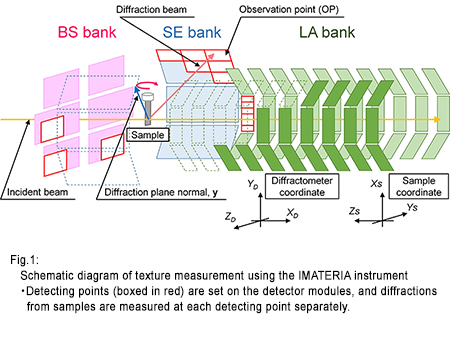
 * Click here to enlarge. * Click here to enlarge. |
 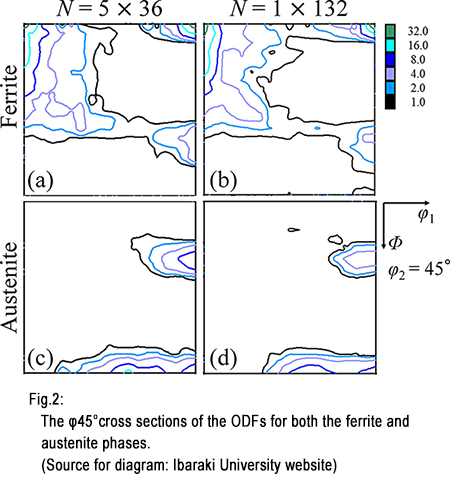
 * Click here to enlarge. * Click here to enlarge. |
| |
| ▲to Page Top |
| |
|
| ● Commercialization of Eco-Tires Based on Results of Using J-PARC |
|---|
| By using "Advanced 4D Nano Design," a new material development technology developed using J-PARC and other facilities, Sumitomo Electric Industries, Ltd. has commercialized new eco-tires which improve wear-resistance performance by 51% over previous products, while maintaining low fuel consumption and grip performance at a high level. This result was achieved through continuous, clear analysis of the internal structure of rubber, from the nano to the micron level, and the ability to carry out simulations. The Materials and Life Science Experimental Facility (MLF), the world's largest synchrotron radiation facility (SPring-8), and the K supercomputer were used to develop this technology. |
| |
| ▲to Page Top |
| |
|
| ● Meeting of Technology Evaluation Committee for Muon g-2/EDM Experiment (E34) (November 15-16, J-PARC) |
|---|
| At J-PARC's Muon Experimental Facility, a g-2/EDM experiment (E34) has been proposed for performing precise measurement of the anomalous magnetic moment (g-2) and electric dipole moment (EDM) of the muon particle. Recently, there was a meeting of the Technology Evaluation Committee, with 18 expert members from inside and outside Japan, and a review was conducted of the experiment technology. Signs have been seen in previous experiments that the value of the anomalous magnetic moment of the muon deviates slightly from the predictions of the standard theory. In the E34 experiment, the possibility of new physics beyond the standard theory of elementary particles will be verified by measuring g-2 and EDM at ultra-high precision using new experimental techniques completely different from previous approaches. |
| This committee meeting brought together persons responsible for implementation of a similar experiment planned in the U.S., as well as experts in muon beams, lasers, accelerators, magnets, and other areas. The experiment technology was verified and evaluated, and there was an enthusiastic exchange of views from a wide range of specialized perspectives. |
| |
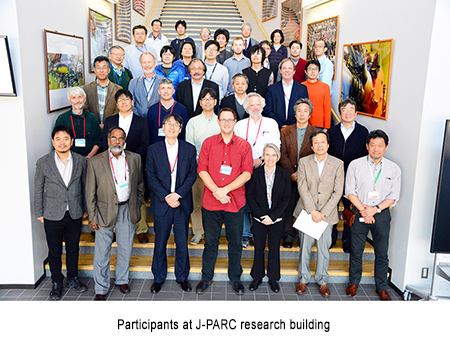
 * Click here to enlarge. * Click here to enlarge. |
| |
| ▲to Page Top |
| |
|
| ● Fiscal 2016 General Training for an Emergency Situation at J-PARC (October 28, J-PARC/MLF) |
|---|
| General Training for an Emergency Situation at J-PARC was carried out on October 28 assuming a fire in a radiation controlled area of the MLF. In this training, workers calmed down the situation, notified relevant management/authorities, and simulated AED resuscitation and transport to the hospital of a worker engaged in firefighting activities who became ill and went into cardiopulmonary arrest. The training was carried out without informing the participants beforehand about the location of the fire or the occurrence of a person with cardiopulmonary arrest, so abilities to respond in an emergency were tested. In gathering and communicating information, a number of improvement points were confirmed, and going forward, those points will be used to further strengthen the ability to respond in an emergency. |
| |
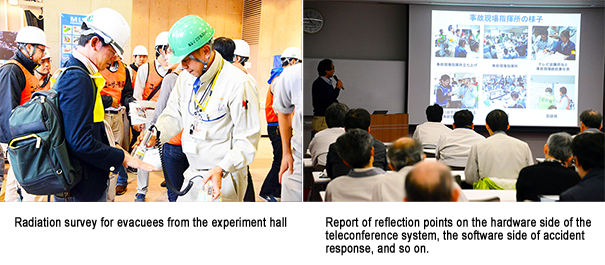
 * Click here to enlarge. * Click here to enlarge. |
| |
| ▲to Page Top |
| |
|
| The Materials and Life Science Experiment Facility carried out adjustment operation from November 2, and started operation for users at 150 kW from November 7. In addition, the Neutrino Experimental Facility began operation for users on October 27, and is currently operating at 330 kW. |
| |
| ▲to Page Top |
| |
|
| ● 13th International Workshop on Spallation Materials Technology (October 31 - November 4, Chattanooga, Tennessee, U.S.) |
|---|
| This workshop was held by the Oak Ridge National Laboratory (ONRL) in the U.S., and there were 58 participants from 8 countries. Information was exchanged on topics such as radiation damage to neutron source materials for nuclear spallation, corrosion due to liquid metal, and cavitation damage. There were 54 presentations from the different countries, and there were 8 reports from J-PARC on the current state of the MLF mercury target, and the muon target. At this workshop, there were lively discussions on evaluating shared issues relating to targets, and solution of remaining problems with target materials. |
| |
| ▲to Page Top |
| |
|
| ● Facility Inspection of Materials and Life Sciences Experimental Facility (MLF) (November 4, J-PARC) |
|---|
| Due to progress in construction of the high-speed muon instrument (H line) in Experimental Hall #1 of the MLF, the facility was inspected on November 4 by the Radiation Management Institute, a nationally registered inspection body. The inspection was passed on the 7th. This inspection involved document inspection, on-site confirmation of shielding, dose measurement, and other checks, and work will now begin to install various systems in the beamline. |
| |
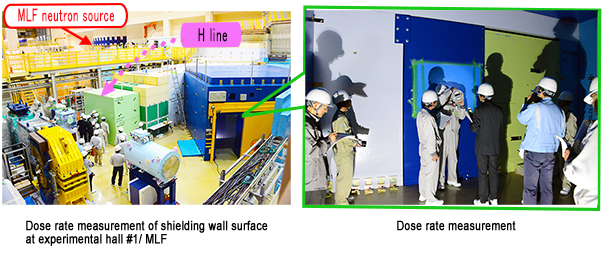 |
| |
| ▲to Page Top |
| |
|
| ● J-PARC Center Outreach Activities |
|---|
| To stimulate interest in science among children, the J-PARC Center holds J-PARC Hello Science classes featuring scientific experiments. These classes consider topics such as the operating principle of accelerators and the mysteries of neutrino oscillation, and are held at various event venues and in the classroom at schools. Public relations advisor Shinichi Sakamoto of the Public Relations Section directs hands-on experiments where participants do projects using hand-made experimental equipment and materials, on themes such as static electricity, electromagnets, and waves. Events were held this month at: a facility tour of the Naka Fusion Institute of the National Institutes for Quantum and Radiological Science and Technology (QST) (November 3, Naka city adjacent to Tokai village), the Science Club of Muramatsu Elementary School (November 16, Tokai village), and a Science Cafe presented by the High-Energy Accelerator Research Organization (KEK) at the Tamarokuto Science Center (November 23, Nishitokyo city). At Science Agora 2016, held at the National Museum of Emerging Science and Innovation (Miraikan) (November 3 - 6), experiments on electromagnets and static electricity were showcased at the exhibition booth of KEK. |
| |
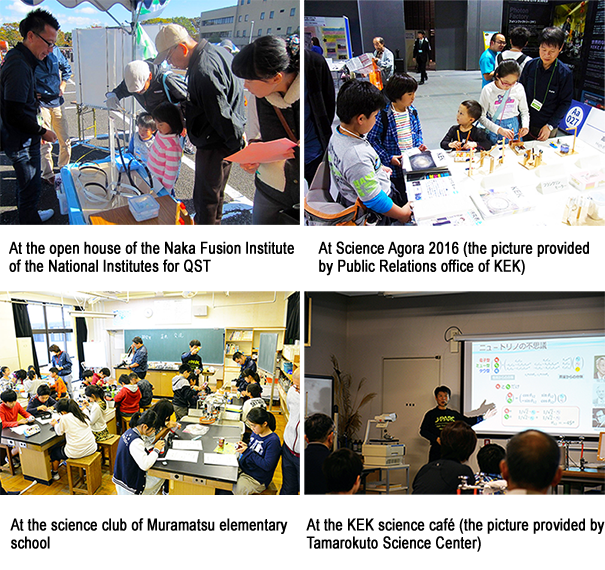 |
| |
| ▲to Page Top |
| |
|
©2017 J-PARC Center. All rights reserved.
|
|